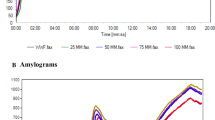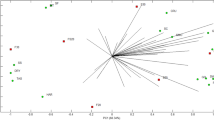Abstract
Cookies high in proteins and low in calories were prepared by substituting wheat maida with defatted soy flour (DSF) at 0, 10, 15, 20 and 25% levels and sugar with stevia leaves powder (SLP) at 0, 15, 20, 25 and 30% levels using traditional creamery method. Cookies were evaluated for physico-chemical and sensory quality parameters. The thickness and hardness of cookies increased; weight, diameter, spread ratio and spread factor decreased with increasing levels of DSF while there was increase in protein, crude fiber and ash content and decrease in fat and carbohydrate contents. The cookies with 20% substitution each of DSF and SLP scored maximum for all the sensory quality attributes. On storage of such cookies in LDPE, HDPE and PP for 90 days at ambient temperature, the sensory quality attributes were decreased, but the cookies were acceptable. The HDPE was better packaging material than LDPE and PP with regard to sensory quality of cookies during storage.
Similar content being viewed by others
References
AACC (1976) Approved methods of the American Association of cereal chemists. St. Paul Minnesota, U.S.A
Amerine MA, Pangborn RM, Roessler EB (1965) Laboratory studies. Quality–quantity evaluation in principles of sensory evaluation of foods. Academic, New York, pp 349–397
AOAC (1995) Official methods of analysis, 15th edn. Association of Official Analytical Chemists, Washington
Abboud AM, Rubenthaler GL, Hoseney RC (1985) Effect of fat and sugar in sugar-snap cookies and evaluation of tests to measure cookie flour quality. Cereal Chem 62:124–129
Dwivedi RS (1999) Un-nurtured and untapped super sweet non-sacchariferous plant species in India. Curr Sci 76:1454–1461
Dzyuba OO (1998) Stevia rebaudiana (Bertoni) Hemsley: a new source of natural sugar substitute for Russia. Rastitel’nye Resursy 34:86–95
Kaur A, Ahluwalia P, Singh B (2005) Studies on use of isabgol(Psyllium mucilloid) husk in atta for chapati making. J Food Sci Technol 38:75–78
Mc Watters KH (1978) Cookie baking properties of defatted peanut, soybean and field pea flour. Cereal Chem 55:853–863
Onweluzo CJ, Iwezu NE (1998) Composition and characteristics of cassava-soybean and wheat soybean biscuits. J Food Sci Technol 35:128–131
Panpatil VV, Polasa K (2008) Assessment of stevia (Stevia rebaudiana)-natural sweetener: a review. J Food Sci Technol 45:467–473
Panse VS, Sukhatme PV (1967) Statistical methods for agricultural workers. ICAR, New Delhi, pp 70–72
Patel MM, Rao VG (1996) Influence of untreated, heat-treated and germinated black gram flours on biscuits making quality of wheat flour. J Food Sci Technol 33:53–56
Ranhotra GS (1980) Nutritional profile of high protein cookies. Cereal Food World 25:308–309
Riaz MN (1999) Soybean as functional food. Cereal Food World 44:88–92
Sathe SK, Tamhane DV, Salunkhe DK (1981) Studies in saltine crackers. I. Composition and certain physico-chemical changes during baking. Cereal Food World 26:404–406
Singh R, Singh G, Chauhan GS (1996) Effect of incorporation of defatted soy flour on quality of biscuits. J Food Sci Technol 33:355–357
Singh R, Singh G, Chauhan GS (1997) Development of soy-fortified biscuits-II standardization of fat and sugar levels. J Food Sci Technol 34:529–531
Singh R, Singh G, Chauhan GS (2000) Nutritional evaluation of soy fortified biscuits. J Food Sci Technol 37:162–164
Starrat AN, Kirby CW, Pocs R, Brandle JE (2002) Rebaudinoside F, a diterpene glycoside from Stevia rebaudiana. Phytochem 59:367–370
Tripathi AK, Mishra AK (2005) Soybean-a consummate functional food-a review. J Food Sci Technol 42:111–119
Tsen CC (1976) Regular and protein fortified cookies from cookies from composite flours. Cereal Food World 21:633–640
Yamazaki WT, Donelson JR, Kwolik WF (1977) Effects of flour composition on cookie diameter. Cereal Chem 54:352–360
Author information
Authors and Affiliations
Corresponding author
Rights and permissions
About this article
Cite this article
Kulthe, A.A., Pawar, V.D., Kotecha, P.M. et al. Development of high protein and low calorie cookies. J Food Sci Technol 51, 153–157 (2014). https://doi.org/10.1007/s13197-011-0465-2
Revised:
Accepted:
Published:
Issue Date:
DOI: https://doi.org/10.1007/s13197-011-0465-2




